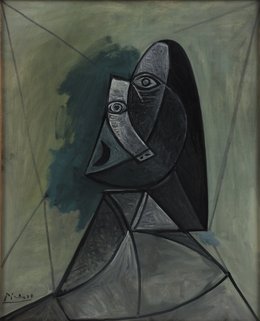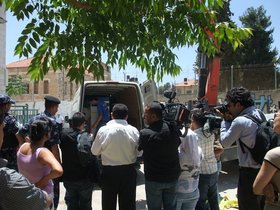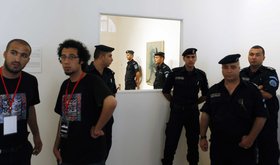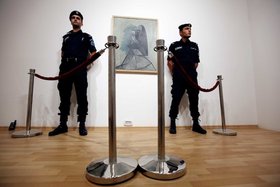Essays
How I became a politician, or,
How theft turned me into an artist
INTRODUCTION
In June this year, a painting by Pablo Picasso arrived in Ramallah, where it was exhibited for one month at the International Academy of Art Palestine. Picasso's 1943 Buste de Femme, on loan from the Van Abbemuseum in Eindhoven, the Netherlands, and estimated to be worth $7 million, arrived in the West Bank after two years of negotiations. Once installed in Ramallah, it caught the attention of the world's media and was lauded as an instance of art's ability to transcend international and local political difficulties.
The images that accompanied reports of the exhibition in the international media inevitably showed the painting flanked by two armed security guards. As such, the painting was always framed within the context of the Palestinian situation, one that necessarily entails security and surveillance. Artist Yazan Khalili's text is a first-person account of one man's audacious theft of the painting from its heavily-guarded viewing space, and questions whether the work could be appreciated in its own right when the political implications of its display were as, if not more, visible than the work itself.
HOW I BECAME A POLITICIAN, OR, HOW THEFT TURNED ME INTO AN ARTIST
It is apparently not complicated to steal an artwork. Unlike in 1999 Hollywood film Entrapment, starring Sean Connery and Catherine Zeta-Jones, the character played by the latter has to endure rigorous training and go through a laser protection system undetected in order to steal an art work. In San Francisco on the 5 July 2011, more than a week after the opening of the Picasso in Palestine exhibition, a man wearing a grey jacket and sunglasses got out of a taxi and walked into the Weinstein Gallery, grabbed a drawing by Picasso, left the museum, hailed another taxi and headed off. He was caught two days later.
On Thursday 23 June, 2011, the night before the opening of the Picasso in Palestine exhibition, and nearly three months before the Palestinian bid for statehood at the United Nations, a fight broke out between police and the Palestinian homeland security forces outside Beit Aneeseh, the bar I recently opened with some friends in Ramallah. I went outside to ask them to take their fight elsewhere because they were blocking the street facing the bar and causing a huge traffic jam. When I reached the policeman blocking the street, he stared intently at me before pushing me, shouting insults and ordering me to go inside. I got mad.
'I'm standing on a public street and I have the right to stand here', I shouted.
'This is our street and if you don't go back inside I will arrest you', he yelled back at me. Not wanting to test how serious he really was, I went inside thinking: who should I call to report a fight between the police and homeland security?
The next evening I attended the opening of Picasso in Palestine at the International Art Academy Palestine, where the artist's seminal and sombre Cubist piece Buste de Femme (1943), brought over from the Van Abbe Museum in the Netherlands, was being exhibited. I didn't know much about the painting except that it is worth around $7 million.
And there they were again; those policemen, filling up the entire area, toting their AK-47s. I began looking at their faces one by one, hoping to spot the one who had shouted at me the previous night. He can't exactly engage in a show of force now, I thought. Unlike the street facing Beit Aneeseh, we were now both bound by the supposed sanctity of this art space. But he wasn't there. I relaxed.
It was crowded. I can safely say there has never been this many people at an art opening in Ramallah. It got even busier when Prime Minister Salam Fayyad arrived with what looked and sounded like a traditional wedding-like train, creating a strange celebratory scene, as if it were the official marriage of art and state.
While everyone was busy eating canapés and engaging in inaudible conversations, I queued up with those waiting to see the 'bride'. It's not as if I had never seen a Picasso painting before but this time it wasn't just a Picasso: it was also Palestine. I once visited Tate Modern in London with an artist friend of mine. I remember telling him that I couldn't find anything interesting in Picasso's work. He agreed, but added instructively that I should be looking at the painter's work within the context of the canon of the history of art, the role his work has played across the years and its effect on contemporary art practice today.
So how should one look at this particular piece by Picasso in this particular context? Should one approach it through its purported relevance to the history of art? Or rather, engage with it through the context of Palestinian contemporary politics?
The gesture of bringing a multi-million dollar Picasso to occupied Palestine under the tutelage of its allegedly legitimate government somehow extends the event of showcasing art deep into the realm of politics, exposing this relation between art and the apparatuses of the state, and suggesting a space where the boundaries between the art world and political practice become blurred. As such: was I looking at a painting by Picasso or at the Palestinian state? Where is the artwork in this exhibition?
They would only allow two people at a time into the specially-built room, claiming that the humidity and the heat people generate affects the life-span of the painting. I was in fact being environmentally conscientious for the first time in my life. In order to enter, my viewing partner and I (who happened to be Maher, the juice-maker from Al-Manara Square) had to pass through a corridor containing all the documentation relating to the entire process of bringing this painting to Palestine. It happens to be a long story, taking in around two years of discussions regarding insurance, security, the Oslo Accords, building the adequate space, and so on and so forth. After a brief walk, we emerged through a sliding door and into a white cube. Without giving it much thought, I turned to the right to look at the painting - and there he was, standing next to the bride! It was last night's policeman with another colleague, in their full police uniform.
I couldn't take my eyes away from them: I kept glancing at him, then at the painting. I began to really think about the installation of sorts that was beginning to unravel in front of me: the wedding-like ceremony; the art work; the Picasso painting extending beyond the borders of the frame to cover the two policemen guarding it; Maher; myself; the space around us; and consequently the whole of the Palestinian Authority. It appeared like an exposé or a political statement announcing the coming state and its security forces, even seeming to perform their very powers. This is exactly one of the zones where art and politics connect: both are engaged in a struggle for recognition. Picasso in Palestine has turned into an art project that is seeking to be recognized as an art project, all the while being a political gesture that is seeking to enact the power of the state and its need to be recognized, albeit at maximum security.
I came to look at Picasso, only to find myself confronted with the state itself. Here, in one room, all my fears of the coming state unfolded. Bringing Picasso to Palestine has turned my attention to what kind of a state this will be: a security state. That dreaded term is a catch-all for multiple forms of surveillance, policing, legitimacy and the exercise of power.
On 19 July, around 2pm, the day before the end of the show, I walked into the white cube wearing a grey jacket and red sunglasses, said hello to the policemen, who immediately recognized me, took the painting off the wall, walked out with it, hailed a taxi and was off.
If bringing Picasso to Ramallah was a political act that exposed the security state, would stealing it be a political act against this very state? Couldn't stealing it, in fact, be considered an art work too?
I was caught a few hours later…
Yazan Khalili's work is part of the Kamel Lazaar Foundation Collection.









